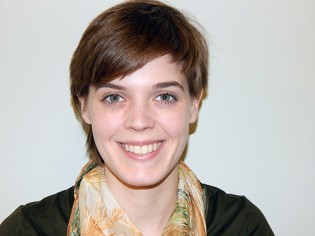Helter-Skelter and Self-Taught

She may not have a formal art education, but Miriam Katin does have a running narrative in her mind that keeps producing ideas.
by Bethany Wolfe
For comic book writer Miriam Katin, being a Jew informs “all of her work in every way,” given that most of her stories involve her religious background and the history of Jews. Much of Katin’s work centers on her experiences with World War II and living in Israel. She was born in Hungary during the Second World War; served in the IDF as a graphic artist in the 1960s; and has since worked as a background designer in both Israel and the United States. While Katin loves creating serious comics and graphic novels, she also enjoys comic relief and says she is sometimes surprised by the stories that pour out of her.
You took part in the show Graphic Details, which showcased the works of Jewish women comic book writers. Did you note any common links or themes in your works?
You mean that gigantic kvetch party? Just kidding, of course (this is comic relief). I was surprised how different we all are in that group, even though there were a few themes that were similar. Our places of birth, education, relationships with men, and even financial backgrounds all make us very, very different. It even charmed me how different the army service had been for me from that of Miriam Libicki. But of course there is a bond just under the surface of any Jewish person.
What inspired you to start creating comics, and what about it has kept your interest/enthusiasm all these years?
I always thought that my stories were really wonderful, and I kept a running narrative in my mind – almost like a third person sometimes. But I am not a writer, and when I discovered comics for myself, it gave me a very natural, perfect way to tell those stories.
What inspires your dynamic illustration style? What is your writing/illustrating process like?
I never had a style until I actually sat down to sketch my first short story on tracing paper with a pencil. I meant to copy that to another paper with clean sharp lines, but that was so boring and it lost so much life. So, I decided to just clean up those pages in Photoshop, and that is how I arrived at what you call my dynamic illustration style. The process? Hmmm. I think, and I draw. Of course it is all there, it must be (for me) before I lift my pencil, but things do happen along the way. Later I look at what I made and can’t believe it came from me, and I am really scared that I can’t do anything that good again. That’s not being very professional I guess.
Were you encouraged or discouraged by your parents/siblings/children to create comic books?
You must know at this point that I don’t have a proper education. I never even finished ninth grade and never studied art. My education is best described as helter-skelter. “Self–styled” sounds much better, is a more respected buzz word. But my parents, yes, they loved my art, and my children were always supportive. Actually, as I always say, my boys raised me on Mad magazine and Tintin.
Your latest book, Letting it Go, was published in 2013 to positive reviews. What project are you working on now?
I don’t know. I don’t have a book in my mind – maybe small stories. My wonderful publishers, Drawn & Quarterly, asked for an 8-page story for their 25th anniversary book, and I am working on that. Hey. Nothing comes easy.
What would you like your legacy to be in the world of comic books?
You must be kidding. Legacy? I am “small potatoes.”
About the Author
Miriam Katin was born in Hungary during World War II. As far as she can remember, there just seemed to have been a war, which reminded people of other wars or that war was imminent. A revolution expected, happened, was over… what is next… This made for strange behavior with warped sentiments and scruples all around. While one is swimming as well as one can in this murky environment, things do puzzle. In pictures and few words, she tries to find the line connecting events, people, causes, and effects. There is also, of course, the pleasure of just looking on.
Bethany Wolfe received her MSc in design and digital media from the University of Edinburgh in Scotland and her BA in English (communications, media, and cultural studies) from Emmanuel College in Boston. Prior to joining HBI, she worked with the Publishing Bureau in Glasgow, Scotland, where she wrote, edited, and designed materials for nonprofits. In addition to her work with HBI, she is the art director for Far Off Places, a literary and arts magazine based in Edinburgh.
There are no comments yet, add one below.







Leave a Comment